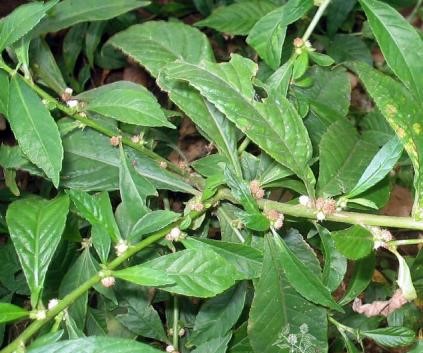Struchium sparganophora

|
|
Struchium sparganophorum Common Names: Water bitterleaf, burr-ragweed,
sparganophorum knapweed Scientific
Classification Kingdom: Plantae Phylum: Tracheophyta Class: Magnoliopsida Order: Asterales Family: Asteraceae Genus: Struchium Species: S. sparganophorum Binomial Name: Struchium sparganophorum (L.) O. Ktze. Synonyms: Ethulia nodiflore Lam., Ethulia sparganophora L., Sparganophoros
sparganophora (L.) C.Jeffrey Morphological Description Struchium sparganophorum, commonly known as water bitterleaf or burr-ragweed, is an annual
herbaceous plant that typically grows to heights of 30–60 cm, occasionally
reaching up to 1 meter in favorable conditions (Tropical Plants Database,
2024). The erect stems are slender, branched, and puberulous, covered with short,
cylindrical hairs and capitate glands, giving a slightly sticky texture. The
leaves are elliptic to lanceolate, 5–15 cm long and 2–5 cm wide, with serrated
margins and a rough, hairy surface on both sides (Kew Science, 2024). The plant
produces small, tubular yellow flowers, 1–2 cm in diameter, clustered in
terminal heads of 5–15 florets, blooming from late summer to early autumn.
Fruits are small, dry achenes, 2–3 mm long, with a pappus of bristles aiding
wind dispersal (Adams, 1972). Distribution and Habitat Native to tropical
America, including Southeast Mexico, Central America, and northern South
America, Struchium sparganophorum has become widely naturalized across West Africa (e.g.,
Nigeria, Ghana), Southeast Asia, and other tropical regions (Kew Science, 2024).
It thrives in diverse habitats such as wet thickets, forest edges, riverbanks,
and floodplains, often becoming a weed in banana and yam plantations (Tropical
Plants Database, 2024). The plant prefers moist alluvial or sandy soils with a
pH of 5.5–7.0 and flourishes in warm, humid climates with annual rainfall of
1,000–2,000 mm and temperatures of 20–30°C, at elevations up to 1,000 meters
(Hutchinson & Dalziel, 1958). Ethnopharmacology Struchium sparganophorum is a staple in West African traditional medicine, valued for
its rich phytochemical content, including flavonoids, tannins, saponins, and
phenolic acids (Aderibigbe et al., 2015). Below are key ethnopharmacological
uses supported by research: · Antimicrobial Properties: In Nigeria, leaf juice is applied to cuts
and ulcers; methanol extracts showed a minimum inhibitory concentration (MIC)
of 250 μg/mL against Staphylococcus aureus, linked to phenolic compounds (Kasim et al., 2011). · Analgesic and Anti-inflammatory: A tea from the whole plant treats
headaches and backaches in Ghana; ethanol leaf extracts (100–400 mg/kg) reduced
acetic acid-induced writhing in mice by 45% and carrageenan-induced edema by
30%, suggesting peripheral and central pain relief (Aderibigbe et al., 2015). · Respiratory Relief: In Togo, infusions manage wheezing and
asthma; the plant’s volatile oils may contribute to bronchodilation, though
specific studies are limited (Burkill, 1985). · Anticonvulsant Effects: In Benin, leaf decoctions treat
convulsions in children; preliminary studies indicate sedative effects in rats
at 200 mg/kg, possibly due to flavonoids (Oshomoh et al., 2018). These uses align with
its role as a tonic, supported by its nutrient profile, including vitamins A
and C, enhancing general health (Oshomoh et al., 2018). ⚠ Toxicity Profile: No significant toxicity is reported for Struchium sparganophorum in traditional or culinary uses. Acute
toxicity tests in rats showed no mortality at doses up to 1,600 mg/kg of
aqueous extract, with only mild sedation observed at higher doses (Oshomoh et
al., 2018). However, its glandular hairs may cause minor skin irritation in
sensitive individuals, and use under guidance is advised to avoid potential
adverse effects (Burkill, 1985). Additional Uses · Culinary Applications: Leaves, containing 3–5% protein and 10–15
mg/100 g vitamin C, are cooked as a potherb or used as a bitter condiment in
soups across West Africa (Adelakun et al., 2014). · Ornamental and Ecological Value: Its bright flowers attract butterflies and
bees, making it a drought-tolerant ornamental in gardens, while its dense
growth serves as ground cover in dry, sunny areas (Tropical Plants Database,
2024). · Nutritional Benefits: The plant provides minor amounts of iron
(1–2 mg/100 g) and calcium (50–70 mg/100 g), contributing to its use as a
health tonic (Oshomoh et al., 2018). References
External Links More Pictures |
|
| Compounds of Struchium sparganophora | |
| References |